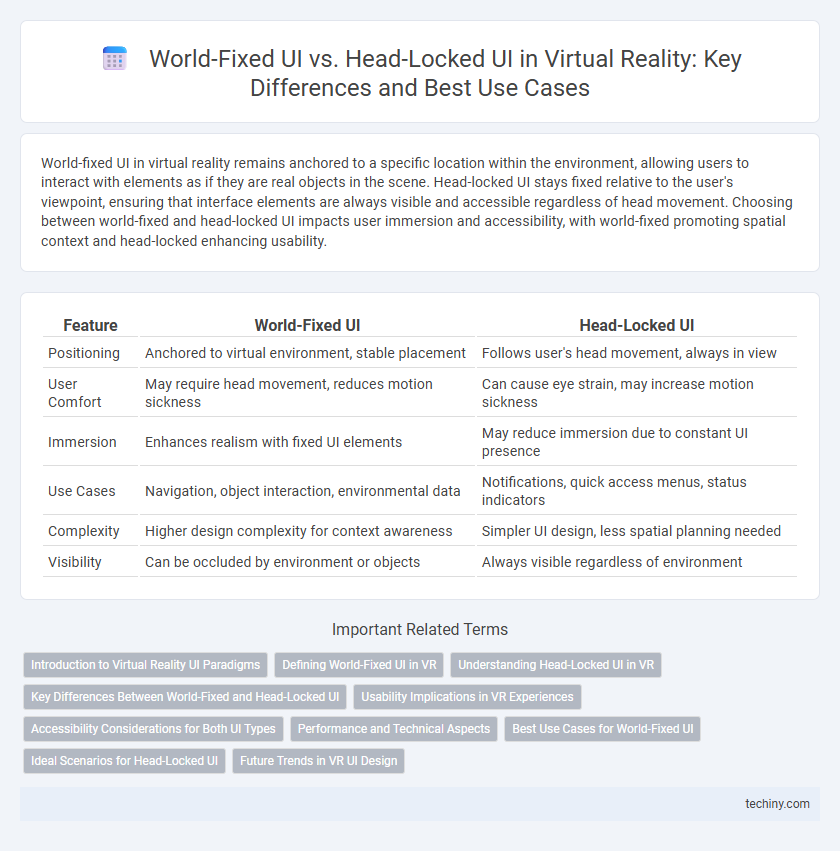World-fixed UI in virtual reality remains anchored to a specific location within the environment, allowing users to interact with elements as if they are real objects in the scene. Head-locked UI stays fixed relative to the user's viewpoint, ensuring that interface elements are always visible and accessible regardless of head movement. Choosing between world-fixed and head-locked UI impacts user immersion and accessibility, with world-fixed promoting spatial context and head-locked enhancing usability.
Table of Comparison
| Feature | World-Fixed UI | Head-Locked UI |
|---|---|---|
| Positioning | Anchored to virtual environment, stable placement | Follows user's head movement, always in view |
| User Comfort | May require head movement, reduces motion sickness | Can cause eye strain, may increase motion sickness |
| Immersion | Enhances realism with fixed UI elements | May reduce immersion due to constant UI presence |
| Use Cases | Navigation, object interaction, environmental data | Notifications, quick access menus, status indicators |
| Complexity | Higher design complexity for context awareness | Simpler UI design, less spatial planning needed |
| Visibility | Can be occluded by environment or objects | Always visible regardless of environment |
Introduction to Virtual Reality UI Paradigms
World-fixed UI in Virtual Reality anchors interface elements to real-world coordinates, providing consistent spatial references that enhance user orientation and interaction within the virtual environment. Head-locked UI, conversely, attaches interface components to the user's viewpoint, ensuring HUD-style accessibility but potentially causing spatial disorientation or clutter. Choosing between these paradigms depends on application requirements, balancing immersion, usability, and contextual awareness in VR design.
Defining World-Fixed UI in VR
World-fixed UI in Virtual Reality refers to user interface elements anchored to specific locations within the virtual environment, maintaining their position relative to the virtual world regardless of the user's head movements. This design ensures that interface components, such as menus or information panels, remain stable and accessible from consistent spatial coordinates, enhancing spatial awareness and immersion. World-fixed UI contrasts with head-locked UI, which moves in tandem with the user's viewpoint, often used for persistent, gaze-focused interactions.
Understanding Head-Locked UI in VR
Head-locked UI in virtual reality maintains interface elements fixed relative to the user's viewpoint, ensuring constant visibility and immediate accessibility regardless of head movement. This design enhances immersion by reducing the need for users to physically look away from the main scene, minimizing distraction and cognitive load. Head-locked interfaces are particularly effective for displaying essential controls, notifications, and status indicators in VR environments where continuous user engagement is critical.
Key Differences Between World-Fixed and Head-Locked UI
World-fixed UI elements remain anchored in a consistent position within the virtual environment, providing users with spatial stability and natural interaction cues. Head-locked UI, conversely, moves synchronously with the user's head, maintaining a constant view but potentially causing motion sickness or reducing spatial awareness. Understanding these differences is crucial for optimizing user experience in virtual reality applications, balancing immersion with usability.
Usability Implications in VR Experiences
World-fixed UI in VR maintains a stable position relative to the virtual environment, enhancing spatial orientation and reducing cognitive load by allowing users to interact intuitively with consistent interface elements. Head-locked UI follows the user's gaze, ensuring constant visibility but potentially increasing visual fatigue and hindering immersion due to lack of stability. Selecting between these interfaces impacts usability by balancing ease of access and environmental integration, influencing user comfort and interaction efficiency in immersive VR experiences.
Accessibility Considerations for Both UI Types
World-fixed UI in virtual reality offers improved spatial orientation and reduces motion sickness by keeping interface elements anchored in the environment, benefiting users with vestibular sensitivities. Head-locked UI ensures constant visibility and easy access, which supports users with limited mobility or visual tracking difficulties but may cause visual fatigue over extended use. Accessibility optimizations include customizable UI scaling, contrast adjustments, and gaze-based interaction for both types to accommodate diverse sensory and motor abilities.
Performance and Technical Aspects
World-fixed UI in virtual reality anchors interface elements to the environment, enabling stable interaction and reducing motion sickness by maintaining consistent spatial positioning, which optimizes rendering performance by minimizing frequent transformations. Head-locked UI, attached to the user's viewpoint, demands continuous real-time updates to match head movements, increasing GPU load and potentially causing visual discomfort due to less stable visual references. Technical considerations include latency sensitivity and tracking accuracy, where world-fixed UI benefits from spatial mapping stability, while head-locked UI requires low-latency tracking to maintain seamless user experience.
Best Use Cases for World-Fixed UI
World-fixed UI is best suited for applications requiring consistent spatial orientation, such as architectural walkthroughs, training simulations, and collaborative workspaces where users benefit from shared reference points. This interface ensures that virtual elements remain anchored in the environment, enhancing immersion and reducing user disorientation. It optimizes tasks involving spatial memory and real-world alignment, making it ideal for navigation aids and educational experiences in VR.
Ideal Scenarios for Head-Locked UI
Head-locked UI excels in fast-paced VR experiences such as gaming and training simulations where rapid access to controls is critical without diverting gaze. It ensures that essential information like health stats, navigation prompts, or tool selections remain consistently visible, enhancing user engagement and reaction time. This UI model is ideal in environments requiring constant situational awareness, eliminating the need to search for menus in the virtual space.
Future Trends in VR UI Design
World-fixed UIs anchor digital interfaces within a consistent position in the virtual environment, enhancing spatial awareness and natural interaction in immersive experiences. Head-locked UIs remain fixed relative to the user's viewpoint, offering immediate access to controls and information, yet potentially causing motion sickness or cognitive overload in prolonged use. Future trends in VR UI design emphasize adaptive hybrid systems that intelligently switch between world-fixed and head-locked modes, driven by user context, task requirements, and eye-tracking data to optimize comfort, usability, and immersion.
World-fixed UI vs Head-locked UI Infographic

 techiny.com
techiny.com